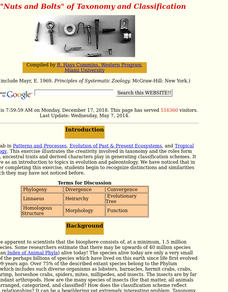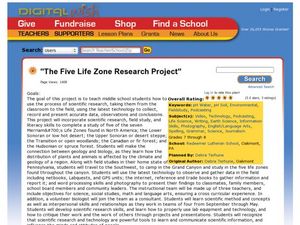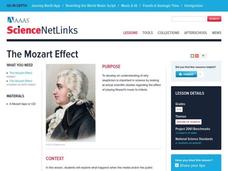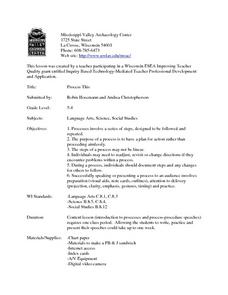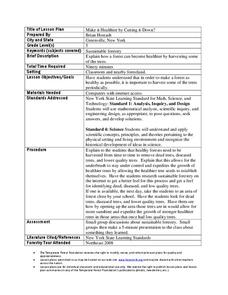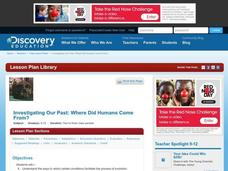Curated OER
The "Nuts and Bolts" of Taxonomy and Classification
Students develop classification scheme that meets the established rules of the Linnaean system. They write one page essay on classification choices.
Curated OER
Inquiry Lesson About Color
Students investigate the color choices artists make in their work, and to practice the scientific process of predicting, observing, inferring, and interpreting. This activity's purpose is to prepare students for a museum visit.
Curated OER
Manipulate Sound Waves
First graders use the scientific process to investigate sound in the classroom and at home. They participate in several hands-on activities exploring sound. They then are introduced to sound vocabulary such as muffled, sharp, and tinkling.
Curated OER
Fractals, An Inquiry: Day 3
Students develop questions for their inquiries and plan their experiments. They are supported by a modeled case study of Max the Dog's Inquiry Planning Process, as well as supported by a planning template, The Inquiry Organizer.
Curated OER
Insect Monitoring
Students participate in an interactive lesson plan using the scientific method to study biodiversity. In this insect monitoring lesson plan, students simulate the layers of soil and the insects that would live there. Students design...
Curated OER
The Five Life Zone Research Project
Students study five of the seven life zones in North America. In this journalism lesson students use the Scientific Method working in teams. They use lab equipment and technology to create a presentation on five of the seven life zones...
Curated OER
Charles Darwin
Young scholars research Charles Darwin and the process he used to develop his theory of evolution. They keep a journal about the skill of observation and make a newspaper of their learning.
Curated OER
The Mozart Effect
Students develop a concept of why skepticism is important in science by looking at actual scientific studies regarding the effect of playing Mozart's music to infants. They record a journal of their inner thoughts and feelings while...
Benjamin Franklin Tercentenary
Science Pen Pals
Students explore the scientific career of Benjamin Franklin. In this science lesson plan, students discuss Franklin's correspondence with other scientists and write letters describing Benjamin Franklin's experiments.
Curated OER
So You Want To Be A Mythbuster?
Students recognize the parts used to construct a car. In this mythbuster lesson, students will use the scientific method to complete an experiment with student constructed cars to bust a myth. Students will reflect on what they have...
Curated OER
Introduction to Friction
Students study the properties of the frictional force between two surfaces in contact. They inspect various phenomena in nature where friction plays an important role and demonstrate
Curated OER
Using Abiotic and Biotic Parameters to Monitor Air Quality
Students identify the abiotic factors that influence a river or stream and the organisms that live in it. They measure several abiotic and biotic parameters to gauge water quality. Students examine the biotic environment by identifying...
Curated OER
Interesting Activities Involving Erosion
Studying erosion in the classroom can be done using a variety of resources including historical texts, videos, and games.
Curated OER
Introduction to Adult Insects and Their Adaptations
Students study organisms found in Class Insecta. They examine the different adaptations these organisms have developed over time to survive and prosper in their respective habitats. They research the origin of the names of several orders...
Curated OER
Air Is there
Learners experiment to observe air and its mass. In this air lesson, students use the scientific method to complete experiments that demonstrate the properties of air. Learners view a video as follow-up.
Curated OER
Rocket Transportation
Students use problem solving skills to lift a load using a balloon rocket. They construct a rocket out of a balloon and use it to carry a paper clip payload.
Curated OER
Shoot for the Moon
Second graders distinguish the different phases of the moon. In this astronomy lesson, 2nd graders study the history of its discovery and myths about its origin. They simulate how the moon's surface is illuminated by the sun.
Curated OER
Can You See It, Touch It, Hear It?
Young scholars develop and practice observational skills through lab activity.
Curated OER
Process This
Students chart the steps, including the problem-solving tangent, and discuss the idea of procedures serving to give us a "road map" or guide to help tackle tasks with preparation and forethought.
Curated OER
Make it Healthier by Cutting it Down?
Fifth graders discuss sustainable forestry. In this forestry lesson, 5th graders discuss how healthy forests need to have dead, diseased and lower quality trees cut down and harvested. They visit a local forest and identify these 3 types...
Curated OER
Scientific Measurement and Conversion
For this measurement worksheet, students review the rules of dimensional analysis and then determine if the 3 equations given follow the dimensional analysis rules.
American Chemical Society
Joseph Priestley, Discoverer of Oxygen
Do you want to hear a joke about nitrogen and oxygen? NO. We all know there is oxygen in the air and that plants produce oxygen, but how was it discovered? Scholars read a handout, answer questions, and analyze material in the...
Leicestershire County Council
Developing Handwriting Skills for Individuals with Autistic Spectrum Disorder
Here is a resource packed with strategies to help individuals with ASD improve their handwriting skills. Intended for the teacher or specialist, the resource provides background information on reasons learners with ASD have difficulty...
Curated OER
Investigating Our Past: Where Did Humans Come From?
Investigate the theories of human evolution. In this research based lesson, learners research and discuss how geographic isolation, interbreeding, generalization, and specialization are factors in the history of humans. Groups work...


